Study on Microstructure and Stress Distribution of Laser-GTA Narrow Gap Welding Joint of Ti-6Al-4V Titanium Alloy in Medium Plate
Abstract
1. Introduction
2. Materials and Test Methods
3. Results and Discussion
3.1. Macroscopic Morphology and Microstructure
3.2. Tensile Strength and Microhardness
3.3. Tensile Strength
3.4. Impact Toughness
3.5. Residual Stress Distribution Before and After Ultrasonic Impact Treatment
4. Conclusions
- (1)
- High-quality 16-mm-thick TC4 Ti-alloy plate welded joints with good side wall fusion, good interlayer fusion, and no porosity, oxidation, and other defects are successfully welded using the laser-arc hybrid heat source and designing the welding torch structure through multi-layer and multi-pass.
- (2)
- The tensile fracture position of the welded joint is at the base metal, the tensile strength is 870 MPa, and the specific strength is 19.3 Nm/kg. The elongation after fracture is 17.8%, reaching 97.2% of that of the base metal and 95% of that of the solid solution aging heat treatment. The average microhardness of the weld zone is the highest, up to 340 HV. During the welding process, α′ martensite is formed in WZ and HAZ, which enhances its strength and hardness.
- (3)
- The uneven distribution of acicular α′ martensite in the weld reduces its toughness, resulting in the impact toughness of the weld being 35 J/cm2, reaching 81.8% of that of BM, and the impact toughness of HAZ is 38 J/cm2, reaching 89.7% of that of BM.
- (4)
- After UIT, the average residual stress within 10 mm from the weld toe is 18 MPa, which is tensile stress, and the average residual stress at the weld root is 17 MPa, which is compressive stress. Compared with that before UIT, the residual stress at the welded joint is reduced by more than 95%. After ultrasonic impact treatment every 10 mm on the surface of the whole test plate, the residual stress on the surface of the whole welded specimen can be controlled within 200 MPa.
Author Contributions
Funding
Institutional Review Board Statement
Informed Consent Statement
Data Availability Statement
Conflicts of Interest
References
- Liu, X.; Cui, W.; Wang, Y.; Long, Y.; Liu, F.; Liu, Y. Effects of Heat Treatment on the Microstructure Evolution and Mechanical Properties of Selective Laser Melted TC4 Titanium Alloy. Metals 2022, 12, 702. [Google Scholar] [CrossRef]
- Tao, J.; Shubing, H.; Longbo, J. Effect of micromorphology at the fatigue crack tip on the crack growth in electron beam welded Ti-6Al-4V joint. Mater. Charact. 2016, 120, 185–194. [Google Scholar] [CrossRef]
- Rae, W.; Lomas, Z.; Jackson, M.; Rahimi, S. Measurements of residual stress and microstructural evolution in electron beam welded Ti-6Al-4V using multiple techniques. Mater. Charact. 2017, 132, 10–19. [Google Scholar] [CrossRef]
- Ou, P.; Cao, Z.; Rong, J.; Yu, X. Molecular Dynamics Study on the Welding Behavior in Dissimilar TC4-TA17 Titanium Alloys. Materials 2022, 15, 5606. [Google Scholar] [CrossRef] [PubMed]
- Hu, F.; Yang, C.; Yuan, Y.; Yu, Y.; Liu, J.; Sun, X.; Chen, C. Weld appearance, microstructure evolution and microhardness of welded joint in the TC4 additive manufactured component TIG welding. Mater. Today Commun. 2024, 38, 108074. [Google Scholar] [CrossRef]
- Gao, F.; Li, P.; Jiang, P.; Liao, Z. The effect of constraint conditions on microstructure and properties of titanium alloy electron beam welding. Mater. Sci. Eng. A-Struct. Mater. Prop. Microstruct. Process. 2018, 721, 117–124. [Google Scholar] [CrossRef]
- Long, J.; Zhang, L.J.; Zhuang, M.X.; Bai, L.A.; Na, S.J. Narrow-gap laser welding with beam wobbling and filler wire and microstructural performance of joints of thick TC4 titanium alloy plates. Opt. Laser Technol. 2022, 152, 108089. [Google Scholar] [CrossRef]
- Feng, X.; Xu, Y.; Shi, Y.; Gu, Y.; Zhang, W. Microstructure and mechanical properties of medium-thickness TC4 titanium alloy narrow gap welded joint. Mater. Lett. 2024, 374, 137150. [Google Scholar] [CrossRef]
- Schneider, A.; Gumenyuk, A.; Lammers, M.; Malletschek, A.; Rethmeier, M. Laser beam welding of thick titanium sheets in the field of marine technology. Phys. Procedia 2014, 56, 582–590. [Google Scholar] [CrossRef]
- Sun, W.; Wang, S.; Wu, M.; Hong, M.; Chen, Y.; Xin, J.; Zhang, P.; Qin, Y.; Fang, N. Revealing tensile behaviors and fracture mechanism of Ti-6Al-4V titanium alloy electron-beam-welded joints using microstructure evolution and in situ tension observation. Mater. Sci. Eng. A 2021, 824, 141811. [Google Scholar] [CrossRef]
- Cui, S.-W.; Yong-hua, S.H.; Cheng-shi, Z. Microstructure and mechanical properties of TC4 titanium alloy K-TIG welded joints. Trans. Nonferrous Met. Soc. China 2021, 31, 416–425. [Google Scholar] [CrossRef]
- Chen, C.; Fan, C.; Cai, X.; Lin, S.; Liu, Z.; Fan, Q.; Yang, C. Investigation of formation and microstructure of Ti-6Al-4V weld bead during pulse ultrasound assisted TIG welding. J. Manuf. Process. 2019, 46, 241–247. [Google Scholar] [CrossRef]
- Wu, M.; Xin, R.; Wang, Y.; Zhou, Y.; Wang, K.; Liu, Q. Microstructure, texture and mechanical properties of commercial high-purity thick titanium plates jointed by electron beam: Welding. Mater. Sci. Eng. A 2016, 677, 50–57. [Google Scholar] [CrossRef]
- Du, J.; Liu, H.; Wang, F.; Bao, W.; Feng, N.; Li, H.; Liu, T. Immersion and electrochemical corrosion properties and combined corrosion mechanism of TC4 alloy by keyhole TIG welding. J. Mater. Res. Technol. 2024, 28, 2455–2465. [Google Scholar] [CrossRef]
- Faraji, A.H.; Moradi, M.; Goodarzi, M.; Colucci, P.; Maletta, C. An investigation on capability of hybrid Nd:YAG laser-TIG welding technology for AA2198 Al-Li alloy. Opt. Lasers Eng. 2017, 96, 1–6. [Google Scholar] [CrossRef]
- Chen, M.; Chenbin, L.; Liming, L. Coupling Discharge Between Keyhole Plasma and Arc Plasma in Laser-Arc Welding of Mg Alloy. IEEE Trans. Plasma Sci. 2014, 42, 1400–1406. [Google Scholar] [CrossRef]
- Yang, H.; Cheng, Z.; Tao, X.; Liu, L. Characterization of low-power pulsed laser-induced single/double arc hybrid heat source bottoming welding of medium-thick plate titanium alloy. Opt. Laser Technol. 2025, 181, 111623. [Google Scholar] [CrossRef]
- Zhan, Y.; Zhang, E.; Ge, Y.; Liu, C. Residual Stress in Laser Welding of TC4 Titanium Alloy Based on Ultrasonic laser Technology. Appl. Sci. 2018, 8, 1997. [Google Scholar] [CrossRef]
- AWS D1.6/D1.6M-2017; Structural Welding Code-Stainless Steel. American Welding Society: Doral, FL, USA, 2017.
- Liu, J.; Zhan, X.; Gao, Z.; Yan, T.; Zhou, Z. Microstructure and stress distribution of TC4 titanium alloy joint using laser-multi-pass-narrow-gap welding. Int. J. Adv. Manuf. Technol. 2020, 108, 3725–3735. [Google Scholar] [CrossRef]
- Liu, Y.; Huang, W.; Yu, B.; Chen, Z.; Wang, P. Fatigue Performance Analysis of Welded T-Joints in Orthotropic Steel Bridge Decks with Ultrasonic Impact Treatment. Materials 2023, 16, 6196. [Google Scholar] [CrossRef]
- Górka, J.; Mateusz, P. Research on the Influence of HMFI and PWHT Treatments on the Properties and Stress States of MAG-Welded S690QL Steel Joints. Materials 2024, 17, 3560. [Google Scholar] [CrossRef] [PubMed]
- Yongzhen, X.; Jiahui, C.; Lei, W.; Li, H. Effect of Ultrasonic Impact on the Fatigue Properties of TC4 Titanium-Alloy Laser-Welded Joints. J. Mater. Eng. Perform. 2024, 33, 11365–11375. [Google Scholar] [CrossRef]
- Song, G.; Xu, Z.; Lang, Q.; Liu, X.; Wang, H.; Liu, L. A Laser-Induced TIG Arc Narrow-Gap Welding Technique for TC4 Titanium Alloy Thick Plates Based on the Spatial Position Control of Laser, Arc and Filler Wire. Metals 2024, 14, 510. [Google Scholar] [CrossRef]
- Wang, F.; Sun, Z.; Liu, Z.; Hai, M.; Wu, Y.; Zhang, J.; Luo, R. Performance analysis on welded joints made of TC4/TA17 dissimilar titanium alloys. Ocean. Eng. 2024, 294, 116758. [Google Scholar] [CrossRef]
- Wu, P.; Wang, M.; Fang, N.; Xu, K.; Sun, L.; Huang, R.; Qin, J. Analysis on the technology, microstructure, and mechanical properties of Ti-6Al-4 V alloy narrow gap oscillation laser welding with multi-stranded wire. Int. J. Adv. Manuf. Technol. 2023, 128, 729–742. [Google Scholar] [CrossRef]
- Fang, N.; Guo, E.; Huang, R.; Yin, L.; Chen, Y.; Zeng, C.; Cao, H.; Zou, J.; Xu, K. Effect of welding heat input on microstructure and properties of TC4 titanium alloy ultra-narrow gap welded joint by laser welding with filler wire. Mater. Res. Express 2021, 8, 16511. [Google Scholar] [CrossRef]
- Gao, F.; Zhang, Y.; Liu, J.; Yu, W.; Jiang, P. Metallurgical and Mechanical Characterization of Pure Titanium Thick Welds Made Using Laser Narrow Gap Welding Process. J. Mater. Eng. Perform. 2021, 30, 8859–8871. [Google Scholar] [CrossRef]



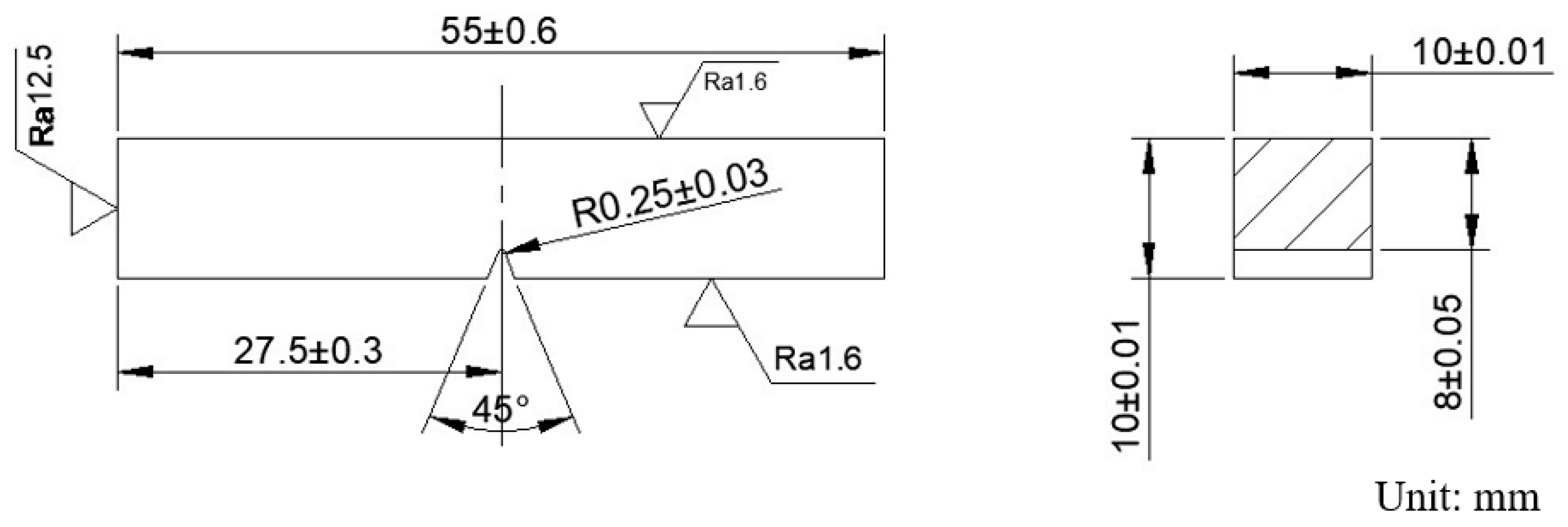
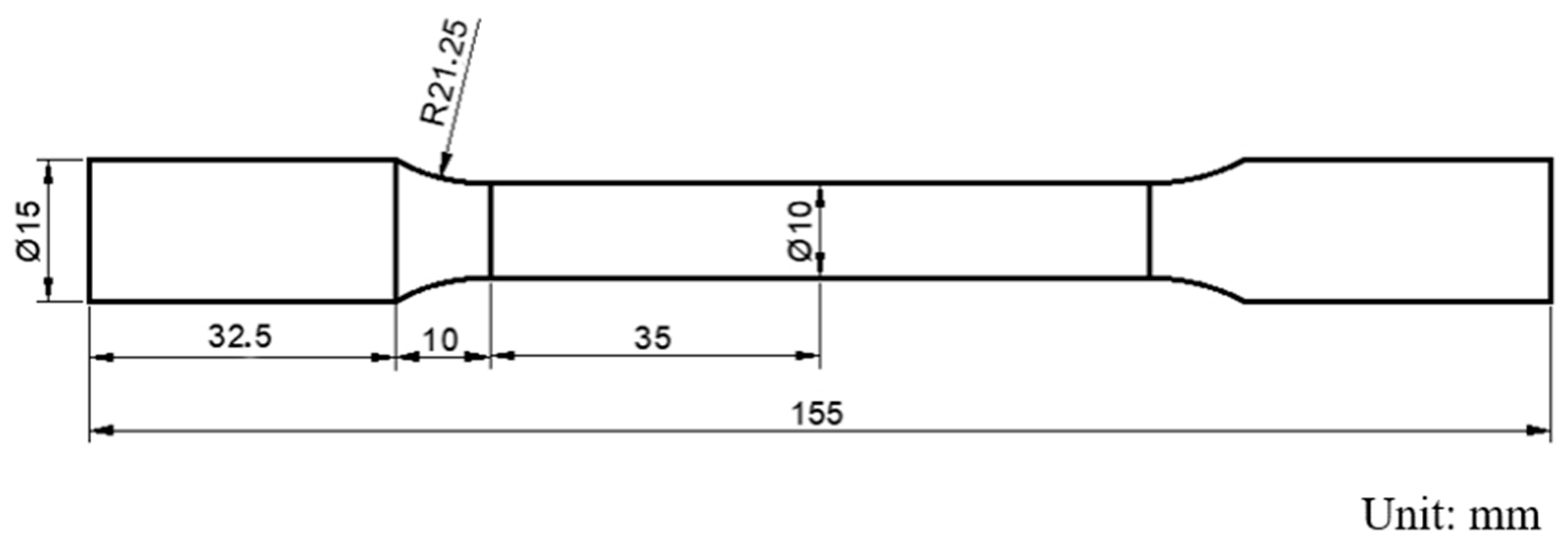



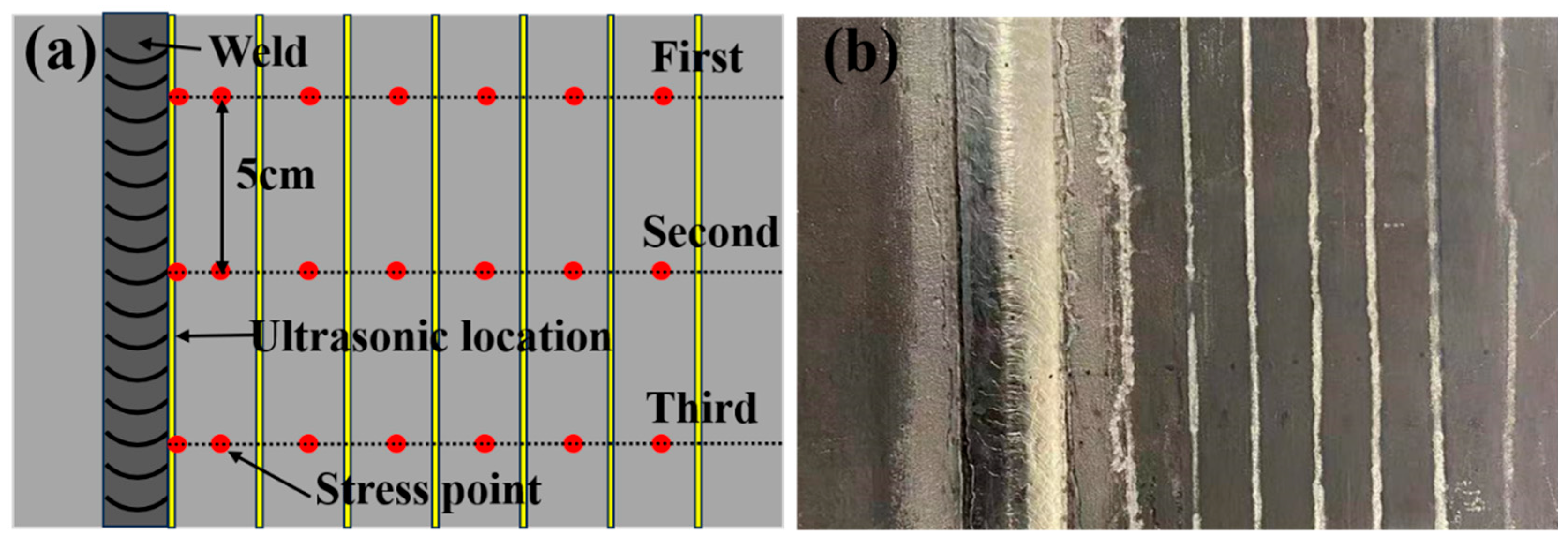





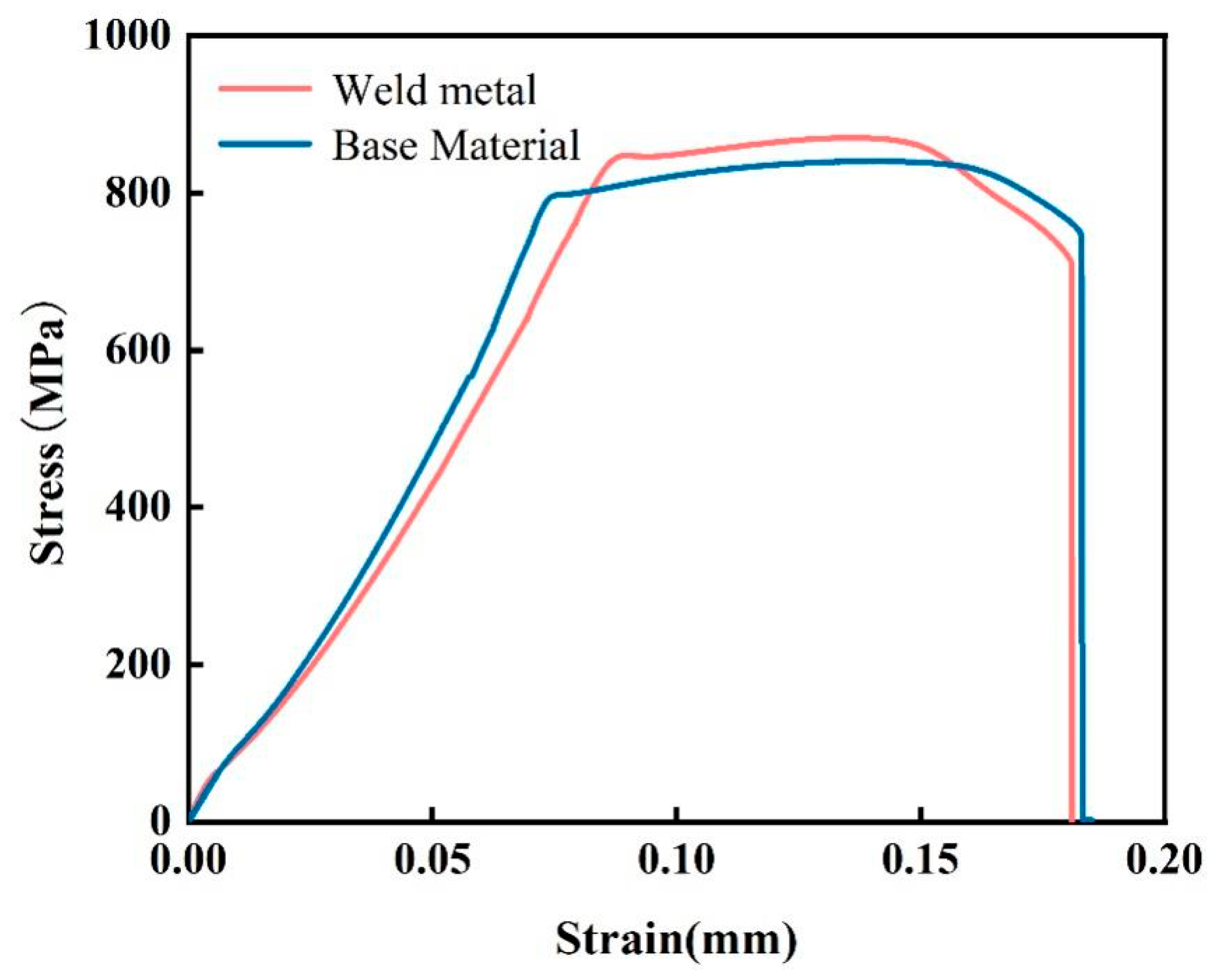
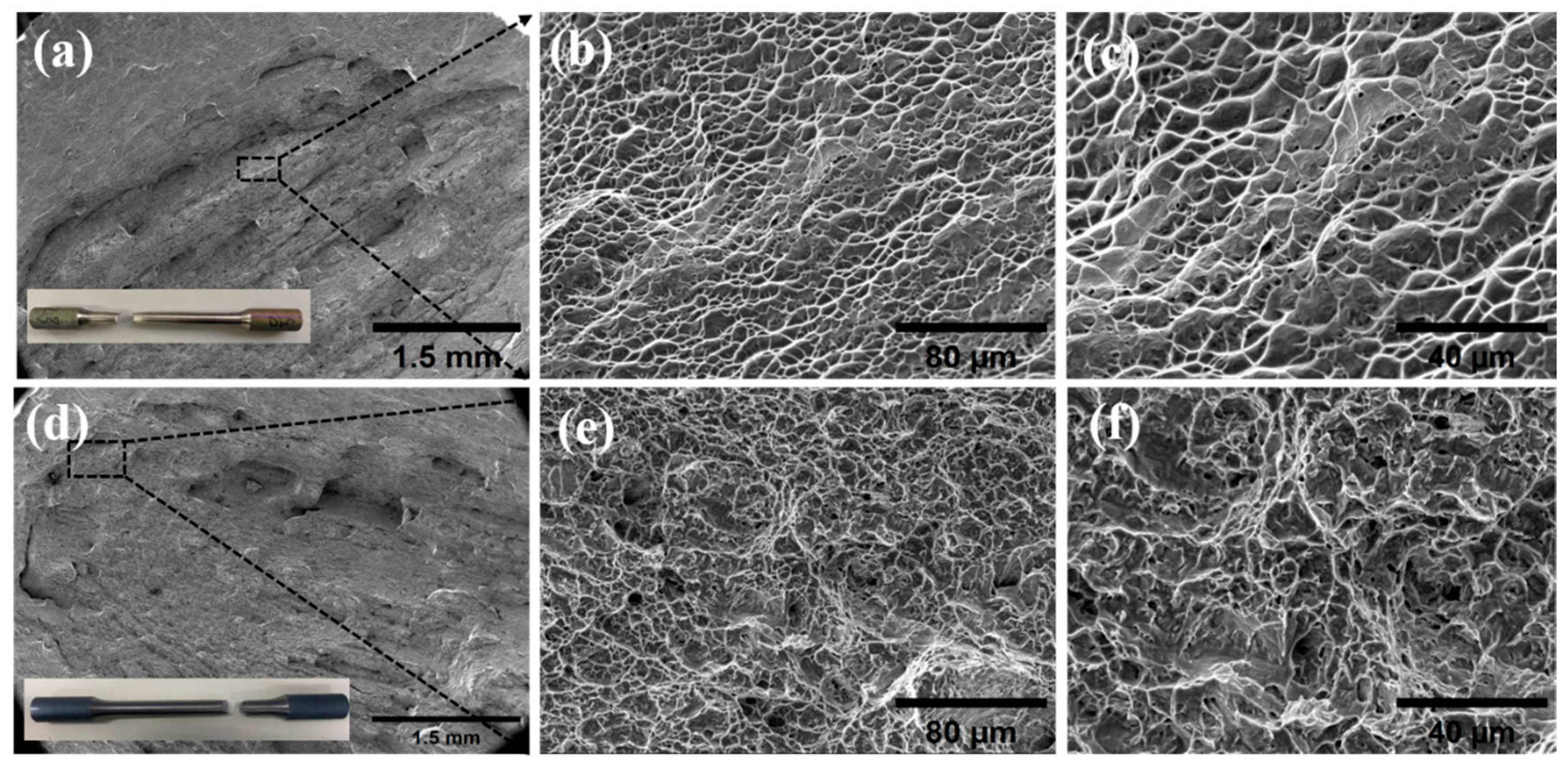


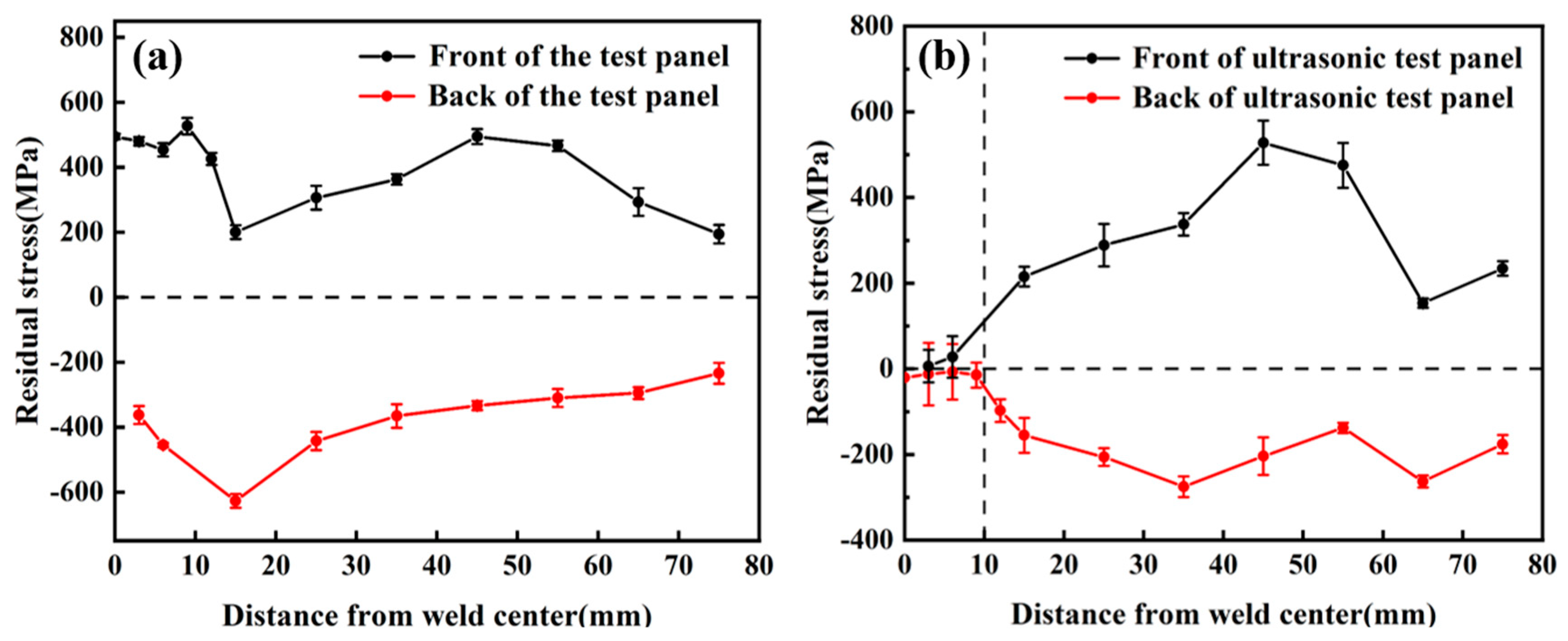
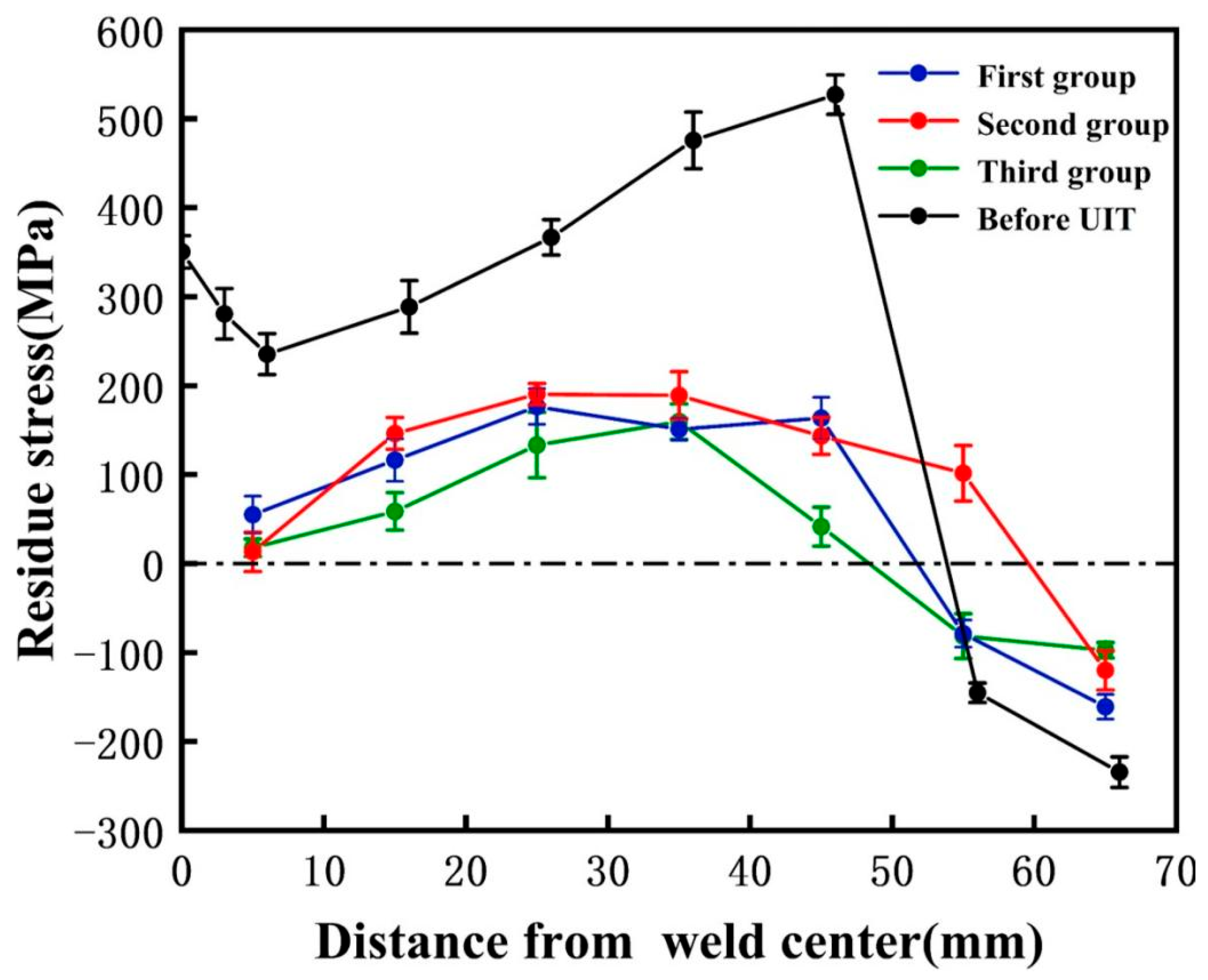
| Element | C | O | Fe | V | Al | Ti |
|---|---|---|---|---|---|---|
| Content | <0.10 | <0.20 | <0.30 | 3.5~4.5 | 5.5~6.8 | Bal |
| σb (MPa) | σn (MPa) | Elongation (%) |
|---|---|---|
| 840 | 790 | 18.5 |
| Welding Manner | Current/A | Welding Speed/(mm·min−1) | Wire Feed Rate/(mm·min−1) |
|---|---|---|---|
| Backing welding | 170 | 300 | nil |
| Filling welding | 200 | 150 | 1000 |
| Cover welding | 220 | 150 | 1200 |
| Output Frequency/kHz | Output Amplitude/μm | Power/W | Impact Velocity/m·s−1 |
|---|---|---|---|
| 40 | 100 | 1500 | 2.5 |
| Tensile Strength (MPa) | Elongation | Breaking Position | |
|---|---|---|---|
| Base metal | 840.3 ± 10.6 | 18.5% | Base metal |
| Joint | 870.1 ± 7.5 | 17.1% | Base metal |
Disclaimer/Publisher’s Note: The statements, opinions and data contained in all publications are solely those of the individual author(s) and contributor(s) and not of MDPI and/or the editor(s). MDPI and/or the editor(s) disclaim responsibility for any injury to people or property resulting from any ideas, methods, instructions or products referred to in the content. |
© 2025 by the authors. Licensee MDPI, Basel, Switzerland. This article is an open access article distributed under the terms and conditions of the Creative Commons Attribution (CC BY) license (https://creativecommons.org/licenses/by/4.0/).
Share and Cite
Cheng, Z.; Lang, Q.; Zhang, Z.; Song, G.; Liu, L. Study on Microstructure and Stress Distribution of Laser-GTA Narrow Gap Welding Joint of Ti-6Al-4V Titanium Alloy in Medium Plate. Materials 2025, 18, 2937. https://doi.org/10.3390/ma18132937
Cheng Z, Lang Q, Zhang Z, Song G, Liu L. Study on Microstructure and Stress Distribution of Laser-GTA Narrow Gap Welding Joint of Ti-6Al-4V Titanium Alloy in Medium Plate. Materials. 2025; 18(13):2937. https://doi.org/10.3390/ma18132937
Chicago/Turabian StyleCheng, Zhigang, Qiang Lang, Zhaodong Zhang, Gang Song, and Liming Liu. 2025. "Study on Microstructure and Stress Distribution of Laser-GTA Narrow Gap Welding Joint of Ti-6Al-4V Titanium Alloy in Medium Plate" Materials 18, no. 13: 2937. https://doi.org/10.3390/ma18132937
APA StyleCheng, Z., Lang, Q., Zhang, Z., Song, G., & Liu, L. (2025). Study on Microstructure and Stress Distribution of Laser-GTA Narrow Gap Welding Joint of Ti-6Al-4V Titanium Alloy in Medium Plate. Materials, 18(13), 2937. https://doi.org/10.3390/ma18132937






